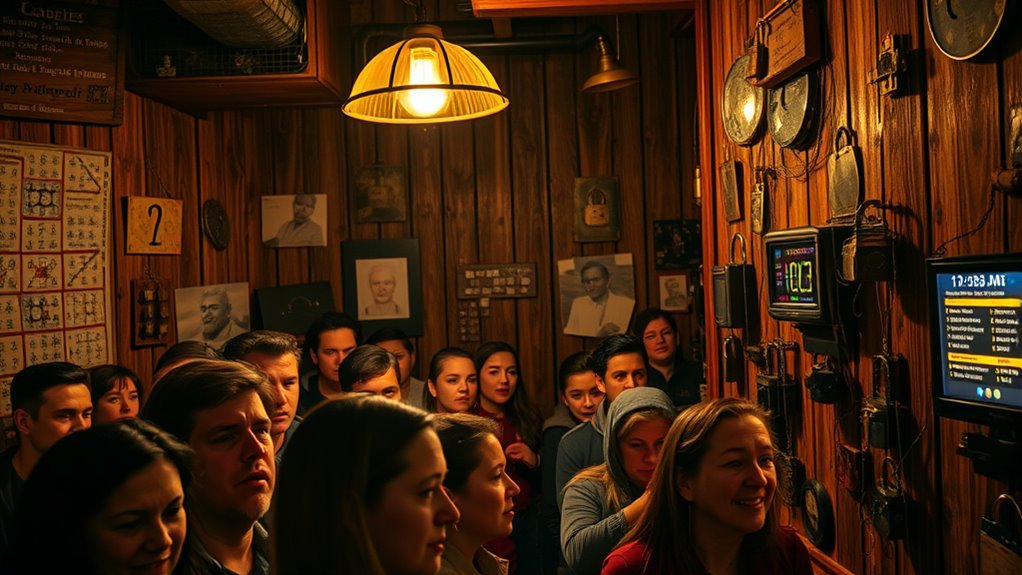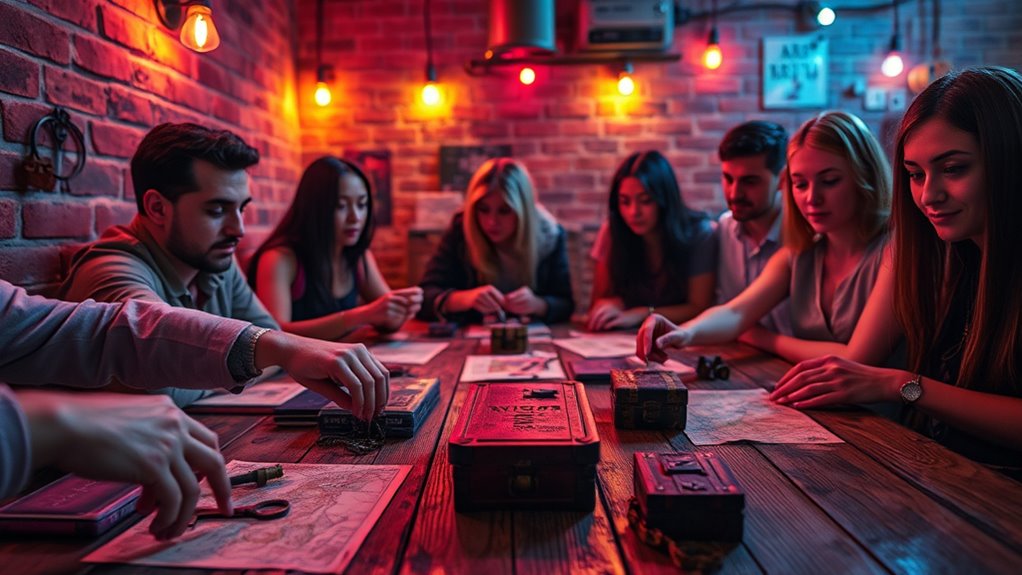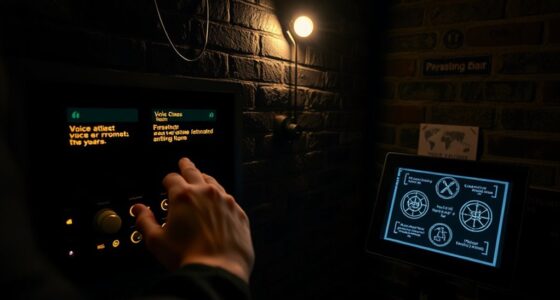Escape room difficulty levels are designed to balance challenge and fun by matching puzzles to your group’s experience and teamwork skills. Easier rooms feature straightforward clues and minimal coordination, while more difficult ones involve layered puzzles, creative thinking, and better collaboration. The goal is to keep you engaged without frustration. As you explore further, you’ll discover how themed puzzles and adaptive challenges help create the perfect immersive experience for everyone.
Key Takeaways
- Tailor difficulty to group experience, ensuring challenges are engaging without causing frustration.
- Incorporate themed puzzles that match the storyline to enhance immersion and engagement.
- Use varying puzzle complexity and layered clues to gradually increase challenge levels.
- Promote teamwork by designing puzzles that require communication and diverse problem-solving skills.
- Offer hints or adjustable difficulty settings to balance challenge and fun for all players.

Escape rooms come in a variety of difficulty levels, catering to players of all experience and skill levels. Whether you’re a first-timer or a seasoned escape artist, understanding how the challenge scales can help you choose the right experience. Many rooms are designed with themed puzzles that match their storyline, immersing you in an engaging world where every clue and lock feels like part of a larger narrative. These themed puzzles often require you to think creatively, observe details carefully, and piece together clues that fit seamlessly into the story. As the difficulty increases, puzzles tend to become more complex and layered, demanding sharper problem-solving skills and a keen eye for detail.
Escape rooms vary in difficulty, with themed puzzles and teamwork evolving to challenge players of all skill levels.
One of the most critical elements that influence difficulty is player teamwork. In easier rooms, the puzzles might be straightforward, allowing players to work independently or with minimal coordination. But as you move into more challenging rooms, teamwork becomes essential. You’ll need to communicate clearly, delegate tasks efficiently, and combine your different strengths to crack the codes and release the next stage. Themed puzzles often encourage collaboration because they may require multiple perspectives to solve. For example, one team member might analyze a cryptic riddle while another searches for hidden compartments. This teamwork-based approach not only adds to the fun but also enhances the overall challenge, making the experience more rewarding when you finally succeed.
Difficulty levels also influence how the puzzles are structured. Easier escape rooms tend to have fewer steps and more obvious clues, making it accessible for beginners or casual players. On the other hand, more advanced rooms usually feature multi-layered puzzles embedded within the theme, requiring critical thinking, pattern recognition, and sometimes even a bit of trial and error. Themed puzzles in these rooms are carefully designed to push your limits, testing your ability to interpret clues under pressure. Additionally, understanding the difficulty levels can help you better prepare for the type of challenge you’re about to face. The balance lies in keeping the challenge engaging without becoming frustrating, which is why many escape rooms offer varying difficulty settings or hints to help you along the way.
Ultimately, selecting the right difficulty level means considering your experience, your group’s teamwork skills, and what kind of challenge you’re after. A well-designed escape room balances themed puzzles and teamwork to create an immersive, thrilling experience that’s fun and satisfying, no matter your skill level.
Frequently Asked Questions
How Can I Determine the Right Difficulty Level for My Group?
You can ascertain the right difficulty level for your group by considering their experience with themed puzzles and teamwork dynamics. Start by asking about their puzzle-solving skills and familiarity with escape rooms. Choose a level that encourages collaboration without causing frustration. Observe their problem-solving pace during the game, and adjust difficulty if needed. This approach ensures everyone stays engaged and has fun while facing an appropriate challenge.
Do Escape Rooms Adjust Difficulty During Gameplay?
Like a chameleon changing its colors, some escape rooms employ dynamic difficulty with adaptive puzzles, adjusting challenges in real-time. They monitor your progress and tweak the puzzle complexity accordingly, ensuring the experience remains engaging without becoming frustrating. This approach keeps the game balanced, catering to your group’s skill level, and guarantees everyone stays immersed and excited, no matter how quickly or slowly you solve the riddles.
What Skills Are Needed for Higher Difficulty Escape Rooms?
To succeed in higher difficulty escape rooms, you need strong puzzle-solving skills and excellent team collaboration. You’ll be expected to analyze complex clues, think critically, and work seamlessly with your team to share ideas and divide tasks efficiently. Staying calm under pressure helps you stay focused, while adaptability allows you to approach challenges from different angles. Improving these skills boosts your chances of conquering even the toughest escape room scenarios.
How Do Escape Room Designers Create Balanced Challenges?
Imagine you’re weaving a tapestry of puzzles, each thread carefully chosen. You create balanced challenges by designing themed puzzles that immerse players and using pacing strategies to build suspense without overwhelming. You test the difficulty, adjusting clues and time limits, ensuring players feel challenged but still excited. This delicate dance keeps the game engaging, making every twist and turn a rewarding step forward, perfectly blending challenge and fun.
Are There Universal Tips for Succeeding in All Difficulty Levels?
Yes, focusing on team collaboration and puzzle complexity helps you succeed across all difficulty levels. Communicate clearly with your team, share insights, and divide tasks to solve puzzles efficiently. Stay patient, don’t get frustrated with complex puzzles, and keep an eye on time. Remember, balancing puzzle difficulty with teamwork makes the experience enjoyable and increases your chances of escaping successfully, regardless of the challenge level.
Conclusion
As you step back from each challenge, remember that every lock you open symbolizes growth, and every puzzle solved reflects your resilience. Balancing difficulty is like tuning a musical instrument—too tight, and it’s strained; too loose, and it’s dull. Embrace the journey, knowing that each level is a stepping stone, shaping your skills and confidence. In the end, the true treasure isn’t just escaping—it’s discovering the strength within you to conquer any mystery.









